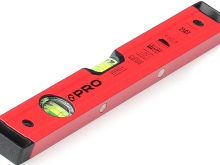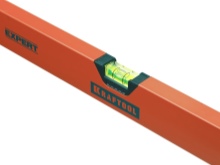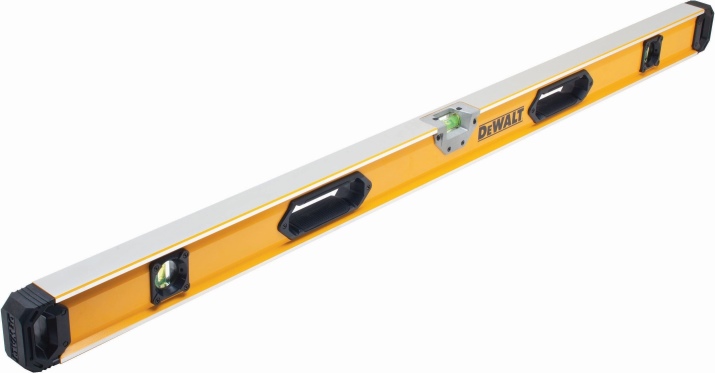Bubble building levels: varieties, brands, selection, use

The purpose of the building level is the ability to control the strict horizontality and verticality of building structures. This is an indispensable tool for pouring a concrete foundation and floor screed, erecting walls, installing windows and doors, poles in the local area, building ancillary buildings, etc. Even the correct installation of a washing machine and refrigerator is not complete without the use of a building level.


Purpose and principle of operation
The simplest bubble level includes an aluminum base (closed profile), which is a perfectly flat rectangular body with a properly selected center of mass. The latter is necessary so that the tool moves and falls as little as possible from the measured surface. 3 ampoules help to track the horizontal, vertical and diagonal (45 degrees) levelfilled with a light and very fluid liquid (for example, alcohol), on which a central and two side marks are applied.


When at least a small microcrack appears in the ampoule with liquid, the latter begins to evaporate, and the use of the level becomes impossible.
The filling of the level ampoules with liquid is approximately 95%. This is enough so that the air bubble is slightly larger than a drop of water or equal in volume to several such drops. It moves along the inner surface of the upper wall of the ampoule, without covering it all. The boundaries of the extreme marks correspond to the edges of the bubble - with a strictly horizontal position of the ampoule, it is between them.
The principle of operation of the building levels is based on the force of gravity. Under the influence of earth's gravity, a heavier and denser medium tends to take a lower position. The lighter one goes up. The density of air is hundreds of times less than the density of water - the bubble is always on top, not below or somewhere in the middle.


Advantages and disadvantages
Compared to hydro levels the advantages of simple bubble levels are obvious.
- No hose is required that can be easily punctured or cut accidentally.
- There is no need for a U-shaped tube, the presence of which makes the level more difficult to store and transport due to its high height. The long and flat level is easier to transport in a suitcase or case with other tools. Packed in a carrying case or case with shockproof inserts, it fits into a common compartment along with long drills and drills, pry bars, wire pieces, long-handled metal scissors, etc.

Compared to laser levels, liquid levels also have advantages.
- No power supply or special electronic sensors are required.
- You don't have to deal with a stripe laser beam. Its accidental contact with the eye is undesirable.
- Dust insensitive.
- Fog and daylight (sunlight) do not interfere with work.
The disadvantages of bubble levels are as follows.
- Compared to hydraulic levels, in the hose of which you can even pour water from the tap, the loss of technical alcohol when the capsule breaks is irreplaceable.
- Bubble levels, like laser levels, do not tolerate shaking, vibration, shock, and should not be dropped.
All levels are subject to mandatory verification at the factory. Using a new level gauge of any kind and variety, it is easy to adjust the old one.

Views
Depending on the functionality, the levels are as follows.
- With one ampoule - only the compliance of the plane with the horizon is checked. The level can be purely vertical.
- With two - the device allows you to check and set the horizontal and vertical planes.
- With three or more - mainly used for laying pipes and supports at an angle of 30, 45 and 60 degrees. Three-ampoule levels are the most common type.



Varieties of any of the above types of levels can be modified as follows.
- There is a ruler scale. Such level gauges are the most common.
- The complex shape of the frame, which differs from the simple rack and pinion. The rail is often made of aluminum, but there are plastic and wooden levels. This prevents the instrument from dropping. But the level itself should not be heavier than a few hundred grams in total weight.
- There are rubberized shockproof (ampoule) inserts.
- Windows can be rectangular, but level gauges with round eyes are more common.
- The lower edge of the rail can be concave, which makes it convenient to align the pipes in level.
- The liquid is tinted for low light measurements.
- Magnets are mounted in the rail - this prevents the level from falling from a vertical and circular horizontal surface, for example, from steel pipes or profiles. The magnetic level will literally protect itself from destruction when dropped.
- The lens, installed in the eye at a certain distance from the ampoule, makes it possible to quickly and better determine the correspondence of the air bubble to the central and lateral marks.
- There is an electronic sensor with a display. Uses a gyroscope, complements a bubble-liquid level gauge. This device is a hybrid device that allows you to determine the displacement of a flask or ampoule in a rail.

The above improvements and improvements enable the foreman to work quickly and accurately.
Manufacturers overview
Among domestic manufacturers of construction level gauges, the following have proven themselves well: "Granit", "Ermak", "Zubr", "Cobalt", "Resanta", "Soyuz", "Steel", "Enkor". "Top" from foreign: 888, Bosch, Dewalt, Eurotex, Kapro, Stabila, Schneider... All these companies regularly participate in the ratings of the best bubble level gauges with three measuring ampoules. The products comply with international standards. These lists are annually compiled by the largest online stores and well-known craftsmen who regularly appear in programs about construction and repair.






Rating of the best models
Over the past year, the highest demand in Russia use the following products:
- Capro Kapro Mini-246;
- Kapro PLUMBSITE GENESIS 781-40-60PM;
- Kapro PLUMBSITE HERCUKES 986-44P-2500;
- STABILA POCKET ELECTRIC-17775;
- STABILA 96-2M 15854-80;
- STABILA 80A-2 16062-200;
- Stanley Torpedo FatMax Pro Box XTHT0-42495;
- Stanley STHT1-43111-60;
- STANLEY FATMAX XL 0-43-681;
- Ada Titan 40 Plus ProLevel 100;
- Ada A00393;
- Ada Titan 2000 A00390.




There are dozens of manufacturers, about half of the firms transferred their production to China. Not all of them produce level gauges that meet modern demands for quality performance.
Selection Tips
If you need a level gauge that is small in length, a 300 mm product is optimal. It will cope with most of the tasks associated with the interior. This level is useful when installing household appliances and furnishing rooms with furniture. Putting a refrigerator, washing machine straight, hanging a shelf or rearranging a cabinet are just a few of the applications for a small building level. An alternative to a small rack-and-pinion level is a flat-capsule level that does not have a rack. But this checks only the horizontal - the air bubble here should be in the center of the circular (two-dimensional) marking. Previously, this "horizontal" was widely used on ships.

For more serious tasks - even laying tiles in a bathhouse, toilet or in the yard, installing complete windows and doors - an average level of at least 600 mm is suitable.
The standard length of large tiles and sections of armstrong suspended ceilings in most cases has a side of a square of 60 cm. To align a door or window, a regular plumb bob will also work. And yet it is easier and faster to set the vertical of a window or door to the bubble level - it does not require waiting for the air bubble to calm down, as would be required from a plumb line or a water column of a hydro level gauge.

Finally, to level the screed and wood flooring horizontally, plastering vertically and obliquely arranged pipe sections diagonally, a large, most accurate of the levels, from 80 cm to 2 m, will be required. The alternative here is only a professional laser level gauge or hydro level. For finishing small rooms and areas, when laser levels in the nearest stores are not available, and the work performed is urgent and urgent, then a large bubble level is your best choice.

When buying a level, be sure to check its main function - the accuracy of the horizontal, vertical or oblique (at a certain angle) line. The seller will adjust several level gauges of different lengths. If the buyer has doubts, the seller can compare the quality of setting the bubble level with any laser or hydraulic one. You can adjust the previously purchased level of any type to the currently purchased bubble level. In this case, it is checked whether the accuracy of the previous level gauge has not been violated, to what extent it is still usable.

Operating rules
After the final check (and adjustment, if required), you can use this product, i.e. proceed with preliminary measurements. Without checking the building level, working with it is fraught with significant errors in measurements, and this is not allowed by any construction or repair. Which level to use - with three bubble gauges or prefer one or two, depends on your current task.
Horizon compliance check
Many lower price range building levels do not have a concave bottom surface. Due to its absence, errors in measurements will increase significantly. Levels with a price above the average mark do not have this drawback - the applied side is already in full readiness. The level is applied to the surface to be measured with this side, and not vice versa. If you attach the tool with the upper, and not the lower, facet, then a bevel is possible even on a perfectly horizontal or the same vertical surface.
The ampoule has two lateral markings, beyond which the bubble should not deviate. The most expensive levels already have four such marks.

One pair of opposite marks in relation to each other is plotted in the form of clear divisions, the second - already barely visible lines. The latter are required to detect the value by which the measured horizontality differs from the perfect one. To clarify the horizontal position, for example, when installing a hanging shelf, do the following.
- Mark the desired point on the wall with a pencil or marker.
- Attach one end of the level to the mark you just made.
- Rotate the level relative to your mark so that the bubble in the horizontal capsule points to the perfect correspondence of the drawn line to the horizon.
- Draw a line along the horizontal level.
- You can install fixtures and hang the shelf. It will hang perfectly straight.

Vertical alignment
Suppose you want to lay out a new wall perfectly evenly or plaster it equally evenly. The second ampoule, installed across the level, is vertical. It is horizontal relative to the surface of the earth. Place a spirit level on a vertical surface. If the bubble is not pushed back to the middle of the ampoule, on which there are marks, the plaster or wall in this place is not ideal. The ampoule with the bubble itself, along which the vertical is determined, should be on top, not below - just like the horizontal ampoule should be as high as possible, and not vice versa.The level gauge is designed in such a way that turning it over will significantly increase the error - do not place it upside down.

Diagonal ampoule
If everything is immediately clear with horizontal and vertical ampoules, then "oblique" is a kind of stumbling block for beginners. There are no difficulties here - this is a diagonal running at an angle of 45 degrees. It is necessary in places where you need to draw a clear bevel between two specific points. Replaces the protractor in this case - you do not need to first cancel the value in half a right angle.
A level equipped with such a goniometer is called a goniometric level.


In cheap "triple" level gauges, the protractor is rigidly fixed in the middle of the right angle, while the expensive ones have a turn signal with a special scale that allows you to adjust an arbitrary angle, for example, 57 degrees.
Follow the steps below to set the desired angle.
- Turn the swivel flask to the desired mark by loosening the fixing screws on the instrument.
- Place the ampoule at the desired angle using a ready-made scale. When turning the ampoule, hold it at each degree for increased measurement accuracy.
- Place the level gauge on a surface such as a pipe at a specific angle. In this case, the air bubble should be in the middle of the ampoule - that, in turn, is located horizontally.
After setting the desired angle, draw a guide line. A pipe or structure will be led along it, the angle for which has already been selected.
For an overview of the Stabila and Kapro building levels, see below.













The comment was sent successfully.